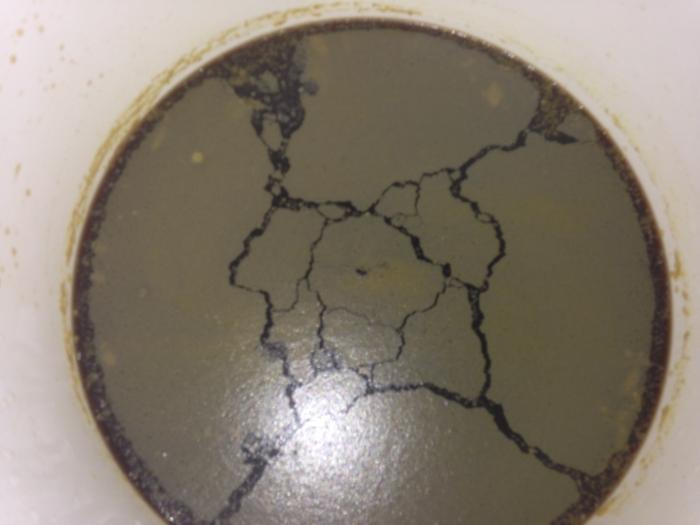You are using an out of date browser. It may not display this or other websites correctly.
You should upgrade or use an alternative browser.
You should upgrade or use an alternative browser.
Infected?
- Thread starter krazy22
- Start date

Help Support Homebrew Talk:
This site may earn a commission from merchant affiliate
links, including eBay, Amazon, and others.
jonnyp1980
Well-Known Member
krazy22 said:I was about to bottle this coffee stout after a week in secondary and the top has a crust over it. The beer smells and tastes fine. I think its infected, but wanted to confirm before tossing the batch.
How long has it been in primary? Don't toss it especially if it smells and tastes fine
CBMbrewer
Well-Known Member
- Joined
- Nov 30, 2011
- Messages
- 760
- Reaction score
- 63
Looks kind of suspicious, but it could just be hop trub and coagulated protein. Since it smells and tastes fine my guess is its okay. If you have another carboy or bucket I would rack the beer from under the "crust" and leave the last inch or so in the primary. If the "crust" forms again or the gravity continues to drop, then I would start to get worried.
jonnyp1980
Well-Known Member
krazy22 said:The beer was in primary for a week and secondary for a little over a week. Will try leaving the crust behind to see if the "crust" forms again.
id cold crash then bottle after you're sure its done fermenting..id avoid racking a third time... good luck update on how this turns out
I see it's tinted green by hop pellet debris. But since it's braking up like ice pack on a lake,it's an infection. I can never remember which one,but it's minor at this point. If the beer is at FG & cleared ok,then rack out from under it & Package it.

$172.35
2 Inch Tri Clamp Keg Manifold With Ball Lock Posts, Pressure Gauge, PRV (0-30 PSI) – Homebrew, Fermentation, Kegging System
wuhanshijiayangzhiyimaoyiyouxiangongsi

$39.22 ($39.22 / Count)
Brewer's Best Home Brew Beer Ingredient Kit - 5 Gallon (Mexican Cerveza)
Amazon.com

$33.95
Five Star - 6022b_ - Star San - 32 Ounce - High Foaming Sanitizer
Bridgeview Beer and Wine Supply

$53.24
1pc Hose Barb/MFL 1.5" Tri Clamp to Ball Lock Post Liquid Gas Homebrew Kegging Fermentation Parts Brewer Hardware SUS304(Liquid Hose Barb)
yunchengshiyanhuqucuichendianzishangwuyouxiangongsi

$53.24
1pc Hose Barb/MFL 1.5" Tri Clamp to Ball Lock Post Liquid Gas Homebrew Kegging Fermentation Parts Brewer Hardware SUS304(Gas MFL)
Guangshui Weilu You Trading Co., Ltd

$10.99 ($31.16 / Ounce)
Hornindal Kveik Yeast for Homebrewing - Mead, Cider, Wine, Beer - 10g Packet - Saccharomyces Cerevisiae - Sold by Shadowhive.com
Shadowhive

$33.99 ($17.00 / Count)
$41.99 ($21.00 / Count)
2 Pack 1 Gallon Large Fermentation Jars with 3 Airlocks and 2 SCREW Lids(100% Airtight Heavy Duty Lid w Silicone) - Wide Mouth Glass Jars w Scale Mark - Pickle Jars for Sauerkraut, Sourdough Starter
Qianfenie Direct

$20.94
$29.99
The Brew Your Own Big Book of Clone Recipes: Featuring 300 Homebrew Recipes from Your Favorite Breweries
Amazon.com

$176.97
1pc Commercial Keg Manifold 2" Tri Clamp,Ball Lock Tapping Head,Pressure Gauge/Adjustable PRV for Kegging,Fermentation Control
hanhanbaihuoxiaoshoudian

$7.79 ($7.79 / Count)
Craft A Brew - LalBrew Voss™ - Kveik Ale Yeast - For Craft Lagers - Ingredients for Home Brewing - Beer Making Supplies - (1 Pack)
Craft a Brew

$22.00 ($623.23 / Ounce)
AMZLMPKNTW Ball Lock Sample Faucet 30cm Reinforced Silicone Hose Secondary Fermentation Homebrew Kegging joyful
无为中南商贸有限公司

$58.16
HUIZHUGS Brewing Equipment Keg Ball Lock Faucet 30cm Reinforced Silicone Hose Secondary Fermentation Homebrew Kegging Brewing Equipment
xiangshuizhenzhanglingfengshop
It looks like it's in a bucket. Keep in mind that buckets are great for fermentation- but if you're going to rack it to a clearing vessel (a "secondary") that a carboy should be used. Once fermentation slows, the protective co2 layer that helps keep the beer from allowing oxygen in stops forming. Racking the beer to a bucket allows a big wine headspace, and usually a wide headspace is part of what allows infections to happen.
That's the reason I traded for the better bottle. The smaller tapered head space seemed like a better idea. I got that same thing once or twice in buckets. So now I just ferment in them. The BB will get all the secondary stuff now.














![Craft A Brew - Safale BE-256 Yeast - Fermentis - Belgian Ale Dry Yeast - For Belgian & Strong Ales - Ingredients for Home Brewing - Beer Making Supplies - [3 Pack]](https://m.media-amazon.com/images/I/51bcKEwQmWL._SL500_.jpg)































